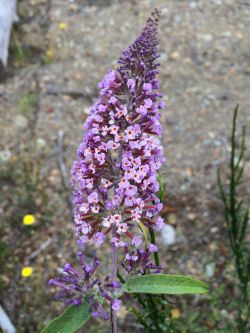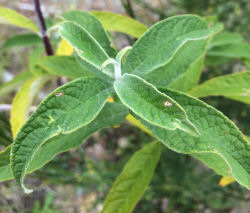


|
|
Practical ecological knowledge for the temperate reader. |
Dye, Wounds
 |
|  |
Synonyms
"Buddleia davidii is a deciduous Shrub growing to 3 m (9ft) by 3 m (9ft) at a fast rate.
It is hardy to zone (UK) 5. It is in flower from Jul to October, and the seeds ripen from Sep to October. The flowers are monoecious (individual flowers are either male or female, but both sexes can be found on the same plant) and are pollinated by Bees, lepidoptera.It is noted for attracting wildlife."
"Suitable for: light (sandy), medium (loamy) and heavy (clay) soils, prefers well-drained soil and can grow in nutritionally poor soil. Suitable pH: acid, neutral and basic (alkaline) soils and can grow in very alkaline soils.
It cannot grow in the shade. It prefers dry or moist soil and can tolerate drought. The plant can tolerate maritime exposure."
"It can tolerate atmospheric pollution." [PFAF]
Status:
Exotic [E-flora]
General:
"Deciduous shrub 1-5 m tall; branches hairy with hairs radiating in a starshape."
[IFBC-E-flora]
Leaves:
"Opposite, egg-shaped to lanceolate, 3-25 cm long, saw-toothed to more or less entire, grey woolly-hairy beneath, green above."
[IFBC-E-flora]
Flowers:
"Inflorescence a large, terminal, branched raceme 15-25 cm long; corollas narrowly tubular below then spreading to 4 lobes, 7-9 mm wide, purplish with an orange eye."
[IFBC-E-flora]
Fruits:
"Sharp-pointed, 2-segmented capsules, 5-8 mm long."
[IFBC-E-flora]
Notes:
Buddleja davidii is considered an emerging invasive species by the Greater Vancouver Invasive Plant Council (2009). An emerging invasive is defined by them as: currently found in isolated, sparse populations but are rapidly expanding their range within the region. [E-flora]
Habitat / Range
"Mesic to dry disturbed areas and rocky slopes in the lowland zone; frequent in SW BC, known from SE Vancouver Island and the lower Fraser Valley; introduced from China." [IFBC-E-flora]
Introduction:
"Butterflybush is an introduced garden shrub from northwestern China and Japan that is now escaped and naturalized in the USA (CA, CT, GA, HI, IL, KY, MA, MD, MI, NC, NJ, NY, OH, OR, PA, SC, TN, VA, WA, WV) and Canada (BC) (USDA 2010). In BC, it is found naturalized in the southwestern part of the province, on southeastern Vancouver Island and in the Fraser Valley. Recent observation has shown spread in the Chilliwack area, including the Chilliwack River and Vedder Canal, as well as along Highway 99 part way to Squamish. It is readily visible and abundant along roadsides when in flower (mid-July to mid-September). Northward spread is temperature limited (tolerant to between -15C and -20C). Efforts to control spread in the Fraser Valley are underway, with some removal in 2009 and inventory to document the extent of spread along the Chilliwack River ongoing (Jeanne Hughes, Fraser Valley Invasive Plant Council, pers. com. 2010)."
[E-flora]
"Buddleja davidii is a shrub of the Scrophulariaceae family, which is native of Eastern Asia and widely spread in Europe, mostly as ornamental plant. In traditional medicine, Buddleja plants are widely used for their wound healing, anti-inflammatory and anti-bacterial properties." [Cosmetics&Toiletries]
Sally M.
Aug 18 2010 12:00AM
"My general interest and research is into wild foods and whilst researching and writing recipes for my wild food e-book, I made syrup this year from Buddleia davidii flowers. It was extremely delicious in its own right without mention of its medicinal qualities. It has, apparently, been used for centuries in Chinese medicine for the treatment of bronchial complaints and is known for its sedative and calming influences upon the system. Through my personal use of it I found it to be of a gently soporiphic nature and definitely excellent for sleep and rest. No harmful side effects noted or experienced when taking one teaspoon up to one dessertspoonful at any given time, although I would not recommend taking it if needing to operate machinery, due to its sedative qualities. One could mix the syrup with fizzy water and ice for a refreshingly different non alcoholic evening drink whilst watching the sun go down!" [PFAF]
"Requires a sunny position[11, 182]. Prefers a rich loamy well-drained soil[11, 200]. Very tolerant of alkaline soils, atmospheric pollution and maritime exposure[200]. Grows best on dry soils of low fertility, where it can seed itself freely[182]. Plants are hardy to about -15oc[184], they resprout from the base if cut back by cold weather[200]. A very ornamental plant[1], it hybridizes freely with other members of this genus. Polymorphic, there are many named varieties, developed for their ornamental value[182]. The flowers emit a musk-like fragrance like heather honey[245]. Plants flower mainly on the current years growth so a hard pruning in spring will encourage better flowering[200]. An excellent plant for bees and butterflies[30]." [PFAF]
"Seed - cold stratify for 4 weeks at 4oc[138] and surface sow the seed in February/March in a greenhouse[78, 113]. Germination usually takes place within 3 - 4 weeks at 21oc[138]. When large enough to handle, prick the seedlings out into individual pots and grow them on in the greenhouse for at least their first winter, planting them out into their permanent positions in late spring or early summer, after the last expected frosts. Seedlings are inclined to damp off and so should be watered with care and kept well-ventilated[78]. Cuttings of half-ripe wood, July/August in a frame[11, 113]. Use short side-shoots[78]. Very high percentage[113]. Cuttings of mature wood of the current season's growth, 15 - 20cm long, October/November in a frame[200]." [PFAF]